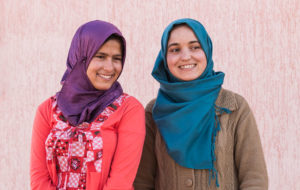
When Laila was 15 years old, she had to leave school to help support her family by selling small goods on the streets of Marrakech. It was grueling work and she lived in fear of violence or assault.
Fortunately, she is back in school and living in a safe home thanks to support from the Promise Pathways project, which aimed to reduce child labor in the Marrakech-Tensift-Al Haouz area of Morocco.
Laila’s story of struggle and her journey from vulnerability to hope is one that thousands of children, youth and families in the region also share. In its four years, the project provided services to more than 3,000 children ages 6 to 14 and over 1,300 youth ages 15 to 17, helping them find opportunities for education and safe employment and helping their families regain stability.
Funded by the U.S. Department of Labor and implemented by Creative Associates International, the project also provided safe and productive employment alternatives for youth of legal working age, through vocational training and referral assistance that links jobseekers with a network of service providers.
For Laila, the project provided the support she needed to access opportunity and find a brighter future.
“I feel strong and capable of assuming this positive change for the good of my family,” says Laila. “Our family’s life has changed and our hopes are reborn.”
Partnerships to support the most vulnerable
Morocco has one of the highest child labor rates in the Middle East and North Africa—despite Moroccan law prohibiting children under 15 from engaging in economic activity.
Partnering to fight this challenge, Creative, the U.S. Department of Labor, the Moroccan government and more than 30 civil society organizations closely collaborated to implement the Promise Pathways project.
This collaboration was key to the project’s success, says Earl Gast, Senior Vice President and Senior Director of Education for Development at Creative.

“The Morocco Promise Pathways project has nurtured strategic partnerships with over 30 civil society organizations as service providers to youth and households in the Marrakech region,” says Gast. “This strong collaboration strengthened systems in Morocco to provide services to vulnerable children and their families beyond the life of the project.”
By bringing together a wide range of actors including youth, parents, schools, communities and the government, the Promise Pathways project’s wrap-around approach to service delivery model—including family-based services, health services, access to micro-credit and more—has helped to create a support network that boosts the resiliency of families and communities and reduce some of the push factors of child labor.
It has connected children and youth who were vulnerable to child labor to quality educational and learning opportunities instead.
With all of these services focused on targeted youth and families, the project increased its chances of addressing their needs holistically, says Najat Sarhani, Chief of Party for the Promise Pathways project, in a 2015 interview discussing the project’s strategic approach.
“It is important that we mobilized an array of partners and those partners worked together in a very coordinated way to provide coordinated services while concentrating on one beneficiary,” she says.
A gathering of these partners in Rabat at a May 16 event called “Promising Transitions: A Celebration of Progress Made and Transitions to Come,” the project transitioned officially to the Moroccan Ministry of Education and Vocational Training, a leader and advocate of the project from the very beginning, along with other government and civil society partners who have pledged to continue their work with beneficiaries
Speaking at the event, Secretary General of the Ministry of Labor, Boutata Mohamed, says the outcomes of the project offer many lessons learned and valuable insights for other regions of the country.
“The project was also useful at the level of the methodology, which we can generalize in other regions of Morocco. This is one of the main results we are proud of, as it ensures the sustainability of the project,” says Mohammed.
Funding for this project was provided by the United States Department of Labor. This material does not necessarily reflect the views or policies of the United States Department of Labor, nor does the mention of trade names, commercial products, or organizations imply endorsement by the United States Government.

